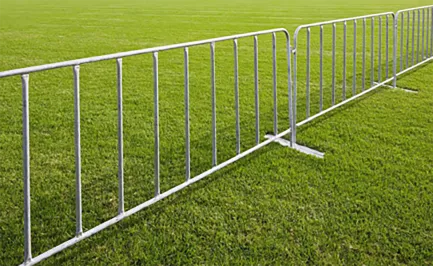
- Afrikaans
- Albanian
- Arabic
- Armenian
- Azerbaijani
- Basque
- Belarusian
- Bengali
- Bosnian
- Bulgarian
- Croatian
- Czech
- Danish
- Dutch
- English
- Esperanto
- Estonian
- Finnish
- French
- Galician
- Georgian
- German
- Greek
- hawaiian
- Hindi
- Hungarian
- Indonesian
- irish
- Italian
- Lao
- Latvian
- Lithuanian
- Luxembourgish
- Macedonian
- Maltese
- Myanmar
- Norwegian
- Polish
- Portuguese
- Romanian
- Russian
- Serbian
- Slovak
- Somali
- Spanish
- Swedish
- Thai
- Turkish
- Turkmen
- Vietnamese
joulu . 18, 2024 12:05 Back to list
Exploring Fencing Options for Australian Temperatures and Climate Conditions
Understanding the Importance of Fencing in Australian Agriculture
Fencing has long been an essential component of agricultural practices in Australia, playing a critical role in maintaining livestock health, managing land use, and protecting crops. In a country characterized by vast landscapes and diverse ecosystems, proper fencing becomes more than just a boundary; it is a vital tool for sustainable farming, environmental conservation, and animal welfare.
The Role of Fencing in Livestock Management
In the Australian outback and rural areas, livestock farming is a cornerstone of the agricultural industry. Fencing is crucial for controlling livestock movement, ensuring that animals remain within designated areas, and preventing them from wandering into roads or hazardous regions. Effective fencing helps farmers manage grazing patterns, prevent overgrazing, and maintain pasture health. By confining livestock to specific areas, farmers can rotate grazing and allow for the regeneration of pastures, which is essential for sustainable farming practices.
Moreover, fencing protects livestock from predators, which can be a significant threat to sheep, cattle, and other farm animals. In regions where wild animals roam freely, such as dingoes and feral pigs, sturdy fencing can deter these threats, reducing losses and ensuring a more stable harvest.
Environmental Considerations
Fencing also plays a vital role in environmental conservation in Australia. By delineating specific areas—such as riparian zones or areas of native vegetation—farmers can protect vulnerable ecosystems from livestock-induced damage. These buffer zones are essential for preserving biodiversity, maintaining soil health, and protecting water quality in nearby streams and rivers.
Additionally, fencing can be used to create wildlife corridors, which provide safe passage for native animals between fragmented habitats. This is particularly important in Australia, where many species are threatened due to habitat loss. By strategically placing fences, farmers can contribute to the conservation of wildlife while maintaining productive agricultural lands.
aus temp fencing

Types of Fencing Used in Australia
There are various types of fencing suitable for different situations and terrains. Common materials used for fencing in Australia include barbed wire, electric fencing, timber, and steel post fencing. Each type has its advantages depending on the intended purpose and the specific challenges of the landscape.
Barbed wire fences are prevalent due to their effectiveness in containing livestock and deterring predators. Electric fencing has gained popularity for its versatility and effectiveness in controlling animal movement with fewer physical barriers. Timber fencing, while often more expensive, provides durability and a traditional aesthetic that some farmers prefer.
The Future of Fencing in Australian Agriculture
As agriculture continues to evolve, so too does fencing technology. Innovations such as solar-powered electric fencing, smart fencing systems integrated with IoT technology, and eco-friendly materials offer exciting advancements for farmers. These technologies not only improve efficiency but also reduce the environmental impact of fencing.
Moreover, the discussion around sustainable practices in agriculture highlights the need for multi-functional fencing solutions. Fences that not only contain livestock but also protect the environment, promote biodiversity, and integrate with natural landscapes will be increasingly sought after. Farmers are challenged to strike a balance between productivity and sustainability, and innovative fencing solutions will be pivotal in achieving this goal.
Conclusion
Fencing in Australia is not merely about marking property lines; it is an integral part of responsible land and livestock management. With the diverse challenges faced by Australian farmers—ranging from wildlife threats to environmental degradation—the importance of effective fencing cannot be overstated. As the agricultural landscape continues to adapt to modern challenges, smart fencing practices will play a crucial role in ensuring the longevity and sustainability of both farms and the ecosystems that support them. By understanding and implementing effective fencing solutions, Australian farmers can safeguard their livelihoods while contributing to the conservation of the land for future generations.
-
Versatile Sheep and Livestock Hurdles for Sale
NewsApr.14,2025
-
The Rise of BRC Fencing
NewsApr.14,2025
-
High-Quality Cattle and Horse Panels for Sale
NewsApr.14,2025
-
Durable Cattle Fencing Solutions
NewsApr.14,2025
-
Double Wire Fencing Solutions
NewsApr.14,2025
-
360 Degree Protection with 358 Anti-Climb Fences
NewsApr.14,2025









